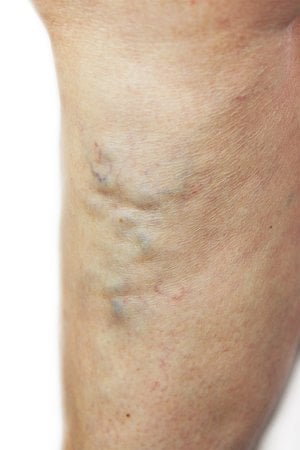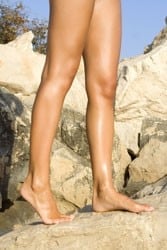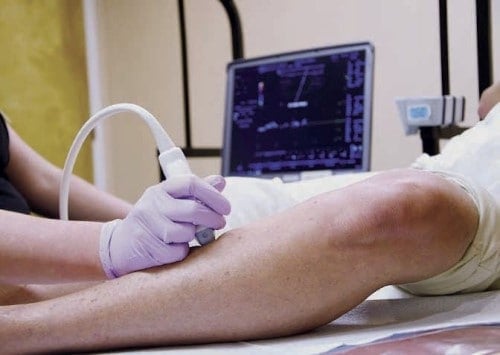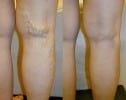Varicose Veins Causes
Varicose veins are abnormally dilated vessels. These blood vessels are located under the upper dermis (layer of skin) and are bulged and swollen. Varicose veins are most common on the legs but can form in other locations. If you suffer from the effects of varicose veins there are many treatments that may be of benefit to you. These include nonsurgical and minimally invasive options.
Varicose veins are usually more uncomfortable, and harmful to your health, than spider veins. In general, veins are responsible for pushing blood against gravity back to the heart. But with varicose veins, the blood flow from the legs back to the heart is diminished by 15-20%, making these dysfunctional veins a burden to your circulation. Specialized varicose veins treatment is aimed at correcting this backward flow of blood.
The actual cause of varicose veins is inefficient, faulty vein valves. These one-way valves, or flaps, usually direct blood towards the heart and prevent the backflow of blood. When these valves do not work properly this condition is referred to as venous insufficiency or venous reflux. These valves don’t close properly, and with vascular pressure, it allows blood to leak back with gravity and pool in the vein. Varicose Veins Treatment is based on the cause of the problem and the stage of the disease. Venous symptoms can range from very mild to severe. Even mild varicose vein symptoms can affect a person’s quality of life.
Over 30% of the population can be affected by varicose veins. Many factors can contribute to varicose veins in the legs, such as age, heredity, hormonal fluctuations, pregnancy and traumas. Heredity is a primary factor in over 80% of varicose vein cases. Other contributing factors may include pregnancy and multiple pregnancies, obesity, hormone therapy, injury and standing or sitting for long periods of time. Many teachers, nurses, flight attendants, hairstylists, etc. fall into that category. The blood back flow causes the leg veins to bulge, stretch and result in many unpleasant side effects. During physical activity the muscles surrounding the veins pump the blood. Valves keep blood from pooling back down in the legs. If the valve isn’t working correctly the blood will pool and a vein may weaken and bulge, causing varicosities. Without proper treatment, valves in the vein worsen.
Symptoms of Varicose Veins and Vein Disease:
- Aching, Throbbing, Pulsing or Sharp Leg Pain
- A feeling of leg discomfort or a general feeling of the legs feeling uncomfortable
- Leg Swelling or Feeling Puffy (Some patients do not notice swelling in their legs, they notice their shoes feel tighter or no longer fit.)
- Blue or Purple Ropey or Squiggly Veins or Lumps, Veins that protrude out or are unsightly
- Veins that stick out and may bleed after minor injury like during shaving or rubbing against clothing
- Lower Leg Fatigue
- Night Cramps in legs or Charlie Horses (leg cramping) during the day
- Redness, Rashes, Darkened or Discolored Skin
- Skin Itching or Burning
- Numbness
- Tired & Heavy Legs especially at the end of the day (Some patients report it feels like they are walking with weights around their ankles.)
- Poor Circulation
- Restless Leg Syndrome
Failure to treat Varicose Veins can cause:
- Bleeding – Varicose veins can bleed after a minimal injury such as shaving, bumping the leg, or a shoe strap rubbing on them. These usually minor injuries can lead to the breaking open of the vein. This occurrence, on occasion, has lead to uncontrollable bleeding which has ended in death.
- Phlebitis, which is a blockage or inflammation of the calves and lower leg veins that becomes red or purple and is painful.
- Venous Stasis Dermatitis with hemosiderin deposits, which are purple or brown discolorations of skin around the ankle area.
- Venous Ulcers can also occur. Once blood leaks out of the veins into the ankle and lower leg area, it leads to breakage of the skin which opens up becoming a wound. These wounds (also called ulcers) can continue to worsen over time.
- Scarring of the skin – scars left behind from healed sores.
- Although varicose vein symptoms are the most common in the legs, they can also involve the ankles and feet.
6 Myths About Varicose Veins
Myth #1
- Varicose veins are just a cosmetic flaw.
- This is untrue. Varicose veins are caused by blood flow restriction which can cause circulatory problems.
Myth #2
- Only women get varicose veins.
- While nearly 25% of women are affected by varicose veins, nearly 15% of men are affected as well. While men are often not concerned about the cosmetic appearance of varicose veins, the symptoms and medical complications of vein disease should not be ignored.
Myth #3
- Varicose veins, or large veins, do not hurt.
- Varicose veins cause swelling of the veins and circulatory problems that can lead to pressure, discomfort and significant pain.
Myth #4
- Varicose veins treatment is invasive and complicated.
- At Advanced Vein Centers we use VNUS Radiofrequency Vein Ablation, which closes off bad veins with a minimally invasive wire procedure and Compression Therapy, helping your varicose veins improve quickly and without pain!
Myth #5
- Varicose Vein Treatment is never covered by insurance,
- If the treatment is determined to be medically necessary it may be covered by your insurance. The Advanced Vein Clinic staff is experienced with working with insurance companies and navigating the insurance pre-authorization process. Contact us if you have questions or would like to begin the insurance approval process.
Myth #6
- Varicose Vein Treatment is rarely successful.
- Our award winning surgeons are caring, highly trained, board-certified professionals who have completed several fellowships. Each member of our surgical staff has 30-40 years of experience. This level of dedication, education and experience combines to achieve a very high success rate and many satisfied patients.

Our Pittsburgh based Board Certified Physicians specialize in comprehensive Varicose Veins Treatment. Their goal is to help patients with Varicose Veins, Spider Veins, Swelling as well as other symptoms caused by vein issues. Our vein specialists use customized, office based, minimally invasive therapies to help alleviate vein symptoms and reduce the risk of future serious problems including venous ulcers and blood clots.
At Advanced Vein Center we use a full range of technologically advanced treatments including Sclerotherapy and the VNUS Closure procedure. VNUS is a state of the art procedure for dealing with vein disease. The Closure procedure is a minimally invasive treatment alternative for patients with a condition known as superficial venous reflux, which often results in varicose veins and other painful symptoms.
Varicose veins are known for their distinctive blue color and bulging appearance under the skin. They afflict an estimated 10%-20% of the adult population. In the United States, that translates into 20-25 million people, the majority of whom are women and older adults. At Advanced Vein Center, we are proud to serve Pittsburgh Pennsylvania area with vein clinics located conveniently in Cranberry Twp, Moon, Chippewa, New Castle, and Hopewell.
3 Steps to Healthy Legs
GET YOUR LEGS BACK UP ON THEIR FEET – TAKE THESE 3 STEPS!

Our Vein Clinic offers an array of vascular treatment options for troublesome varicosities that may be causing discomfort. Varicose veins can impact your overall health and appearance, if you want them removed contact us. It is a good idea to seek varicose vein treatment as soon as possible because vein disease and vein symptoms generally get worse, and become more difficult to treat, over time.
Step 1 Varicose Veins Treatment – Proper Medical Assessment
Large veins may be easier to see, but to determine damaged valves, an ultrasound screening will need to be performed.
- a Doppler sound wave test will check for an abnormality in blood flow and vein structures.
- Ultrasound scanning gives an internal picture of the inside of the leg revealing blood flow directional information that can determine if refluxing is occurring.
Step 2 Varicose Veins Treatment – Choosing the Best Option

- Compression stockings may be the best and easiest place to start. Wearing them can relieve some side effects and decrease the chances of a condition worsening.
- More extensive treatment plans may be recommended. For example Foam Sclerotherapy (or Liquid Sclerotherapy) is an effective treatment that closes the affected vein.
- Non-Invasive Cosmetic Laser Therapy may be recommended. Many of our patients are concerned about how surface veins look. Investigating these aesthetic concerns can reveal more serious underlying medical problems. A non-invasive Laser Treatment for a superficial spider vein, broken capillaries or rosacea can have a boost in self-esteem.
- Vein Ablation through Radio Frequency, or Endovenous Laser Therapy, uses an energy wave at high frequency to close the vein wall with heat. This quick, safe, office procedure causes minor irritation with no downtime. After the procedure resuming normal activity is encouraged immediately. Radio-frequency ablation relieves symptoms of swelling and prevents worsening of bulging and discoloration in leg veins.
All of the available options do not require a long recovery period or an overnight hospital stay.
Step 3 Varicose Veins Treatment – Candidates for Surgical Treatment of Veins
Our board-certified physicians use the latest technology for treatment of varicose veins in a comfortable and safe way. Most insurances cover our specialized vein-care services at the Advanced Vein Centers.
When would surgery be performed on varicose veins?
- Your healthcare provider may consider varicose vein surgery for you only if other treatments have been ineffective. Ask your doctor about other options of less invasive treatments to find the best treatment for your situation.
What’s The Recovery Time After Varicose Veins?
Usually, the recovery time will be based on the type of procedure used, here’s how the timeline of different procedure works:
1. Sclerotherapy: This treatment is minimally invasive when means, you can easily resume most of the activities on the same day. However, you can expect some mild bruising or discomfort for at least 1-2 weeks, which will subside soon.
2. Laser Treatment: You can easily recover in 1-2 weeks, fortunately there’s a really minimal downtime!
3. Radiofrequency Ablation: This treatment recovery time is almost same as Laser treatment as it can also take 1-2 weeks of downtime!
4. Vein Stripping Surgery: It has longer recovery time than most treatments, you will likely need 2-4 weeks with a lot of rest and minimal activity.
Does Developing Varicose Veins Mean You Have A Poor Blood Circulation?
Yes, unfortunately varicose veins are a sign of poor blood circulation, which means if you develop them there’s something wrong with your circulation especially in legs. This condition usually happens when vein walls are weakened and damaged, which pools blood in the veins instead if it flowing back to the heart. Unfortunately, this leads to pressure in veins which causes them to twist and enlarge. Lastly, varicose veins aren’t always there to indicate severe circulatory problems, they can happen because of age, injury and other factors, but in some cases they might be a sign of chronic venous insufficiency.
Can Varicose Veins Recur After The Treatment?
Unfortunately yes, all the treatments treat the existing veins and there’s no guarantee which vein will turn into a varicose vein in future. Already treated veins will not cause any problems, but the ones that can arise in future might be a problem, that’s why it’s important to make sure you follow preventive tips!
Who performs varicose vein surgery?
The following specialists perform surgery on varicose veins:
- Vascular Surgeons
- Phlebologists
- Dermatologists
How is this surgery performed?
Varicose vein surgery is performed in doctor’s offices, surgical centers, and hospitals depending on your situation. One or more types of anesthesia will be used including:
- General anesthesia is administered via IV and gases are given to put the patient into a deep sleep.
- Local anesthesia is administered via injection around certain nerves to numb the area.
What should I expect the day of surgery?

Varicose vein surgery that only uses local anesthesia includes the following steps:
- Change into a patient gown
- Your doctor will mark the veins with a pen to identify them
- You will lie on the exam table to allow access to the surgeon
- Your doctor/surgeon will prepare the skin by cleaning the area
- The local anesthetic will be injected and you will remain awake during the procedure
Varicose vein surgery that uses general anesthesia includes the following step:
The pre-operative nurse will perform an exam and check to ensure all needed tasks are completed and the consent form is signed
After Surgery Care of Varicose Veins
Diet
Immediately after your procedure, start with plenty of clear fluids like water and fruit juices. As long as no nausea is present, begin with soups and other liquid foods, gradually progressing to normal foods as tolerated. Hydration is the most important consideration. Try to drink 6-8 full glasses of water daily (48-80oz). Note: if you’re also undergoing a bariatrics program, follow the dietary instructions given to you by your bariatric team.
Activity
Relative rest is recommended for the first 24 hours. Gentle walking is permitted, but nothing more, especially strenuous lifting. For the next 6 weeks it’s advisable to limit lifting to objects under 10 lbs to ensure that no unnecessary pressure is put upon the treated veins. Your doctor will instruct you as to when you’re cleared to return to work.
Bandages and Dressings
Don’t personally remove any bandages or other dressings. Removal will be done in your doctor’s office during your follow up appointment. Don’t shower until you’re cleared to do so by your treating physician. At the office, your bandages will be removed and the incision sites assessed for proper healing. Once cleared to shower, the white strips placed directly over your incisions should be left in place and will eventually fall off on their own. Until you’re cleared to do so, avoid swimming or using a hot tub or jacuzzi.
Incisions sites
It’s normal to have small amounts of blood or clear fluid seep from wounds at the beginning. This is part of the healing process. It is not normal, however, to have heavier bleeding onto the gauze covering your incisions. It’s unlikely that this will happen, but follow up with your doctor’s office should this occur. Moderate bruising is likely to occur and is normal, the appearance of which may seem excessive but won’t affect the success of the procedure. Be alert for unusual pain or redness, or especially the appearance of a foul smelling drainage. This is very rare, but may be a sign of infection and immediate follow up with your doctor’s office is essential.
Medications
Analgesics (pain meds) and anti-nausea drugs will be prescribed, but often aren’t needed. In most cases, only over the counter pain medications, like Tylenol, will be needed. Avoid NSAID medications like Aspirin, Advil, Aleve, and Ibuprofen, as these thin the blood and can increase bleeding. If narcotic painkillers are used, avoid driving while taking them. Antibiotics may be prescribed to avoid all chance of infection. It’s essential to review with your Surgeon the prescription drugs you’re taking, as medications for diabetes or other conditions may need to be adjusted. When in doubt, don’t hesitate to contact your treating physician’s office with any questions.
Follow up appointments
These are essential, even if you believe that everything is progressing as expected. Normally a follow-up appointment will be scheduled for one to two days after your procedure. At the first follow-up appointment, additional follow-up appointments will be scheduled, if needed. Because these appointments are essential for the best procedure outcome, if you can’t make your appointment, be sure to call and reschedule.
Varicose Veins Surgery Possible Adverse Effects and Complications
Call for an immediate appointment if any of the following occur: unusual redness, pus-like or foul smelling drainage, excessive drainage, excessive pain, or if more than minor swelling occurs.
Other things to watch out for are light headedness, dizziness, vision changes, excessive nausea or vomiting, chest pains, difficulty breathing or diarrhea or constipation. If you are unsure if something is abnormal call the office for an immediate appointment. Our office number is 724-987-3220.
Varicose Vein FAQ
Hereditary (Family History)
Women are more likely to have them than Men
A Sitting or Standing job
Pregnancies
Injury to the Veins
Obesity
Certain Hormones
- Advanced Age
A Sedentary Lifestyle and Excessive Sun Exposure may also contribute to the development of Varicosities.
These items contribute to the backflow of blood in your veins which weakens the vein walls and valves. These weakened valves and veins in your legs cause varicose veins. One-way valves in your veins should keep blood flowing up from your legs toward your heart. When these valves fail, blood collects in your legs and pressure builds up. Varicose veins can become large, tortuous, bulging and painful.
Concerned about your veins? Schedule your Free Vein Screening
The common symptoms of varicose veins are:
- A feeling of leg discomfort or a general feeling of the legs being uncomfortable
- Tired & Heavy Legs especially at the end of the day
- Numbness
- Leg Swelling
- Decreased Leg Circulation
- Night Cramps in legs or Charlie Horses during the day
- Aching, Throbbing, or Sharp Leg Pain
- Redness, Burning or Itching
- Restless Leg Syndrome (RLS)
- Purple or Blue Ropey or Twisted Veins or Lumps, Veins that stick out or are unsightly
- Veins that protrude and may bleed after minor injury like during shaving or rubbing against clothing
- Leg Fatigue
These symptoms can interfere with the quality of life for patients.
If you think you have varicose veins contact us for a FREE screening or consultation.
Do not wait to receive medical treatment as the condition is progressive and can lead to serious medical issues.
Although it is not “dangerous” for most people to have a varicose vein, it does progressively get worse.
Complications from prolonged varicose veins, and vein disease, can become dangerous like blood clots, venous ulcers, wounds and infections.
Vein disease can also have a greater impact on your life and health as it progresses.
The Varicose Vein Treatments that are available include:
- Vein Glue
- Vein Ablation, for example Radiofrequency Ablation
- Lasers and Intense Pulsed Light Vein Treatment
- Microphlebectomies for leg veins
- Foam Therapy for veins
- Vein Sclerotherapy with either foam or prescription grade medication
- EVLT- Endovenous laser treatment which is a procedure in which a small laser fiber is inserted into the vein to close it
- Compression Management of swollen legs
- Lifestyle changes like walking, eating less salt, weight loss, hygiene improvements
- Note: Surgery like vein stripping is mostly considered outdated
The goal of Varicose Vein Treatment is to close off the diseased or damaged veins to allow the blood to reroute to the surrounding healthy veins.
Vein valves should act as one-way flaps that keep blood from flowing backwards as it returns to the heart. If the valves are weak, blood leaks backward into the veins and collect there, which most frequently occurs in the legs. (This problem is called venous insufficiency.) As the veins enlarge from backed-up blood they can become varicose.
Concerned about your veins? Schedule your Free Vein Screening
- Wear support stockings
- Avoid prolonged sitting and standing
- Elevate your legs when at rest
- Walk and exercise
- Limit caffeine intake
- Maintain a healthy weight
For some individuals varicose veins are preventable, for others they can take all the known steps to prevent varicose veins and they will still have them. Every person, and every situation, is unique.
Yes varicose veins can burst.
Concerned about a varicose vein bursting? Schedule your Free Screening today!
Sometimes a combination of different types of therapies are needed to have the best treatment outcome.
Your vein specialist will develop an individualized treatment plan based on your unique situation and then review all the options with you.
Vein disease can be challenging; but, new therapies are now available which make treating vein disease easier and more effective.
Elevating your legs may provide temporary relief of vein symptoms, but it will not cause the actual problem to improve or go away. Elevating the legs can temporarily relieve symptoms because it can temporarily decrease the pressure on the veins. When the legs are down again for a period of time, the pressure will again increase on the veins and the blood will start to pool causing symptoms.
Treating your varicose veins reduces the risk of developing serious health conditions related to the vein disease.
The Vein Specialists at Advanced Vein Clinic use office based, minimally invasive, outpatient procedures to treat varicose veins and vein disease.
A hospital stay is not required to treat varicose veins.
Yes!
Sometimes varicose veins cause no symptoms other than cosmetic issues.
Many patients choose to treat their varicose veins to improve their cosmetic appearance. If other symptoms are not present then insurance is unlikely to pay for their treatment.
We have a variety of payment options and you may be surprised at how affordable vein treatment is.
Contact us for a FREE vein screening or a consultation.
